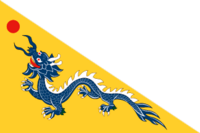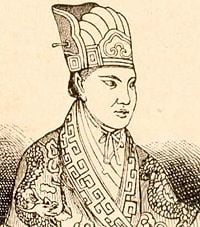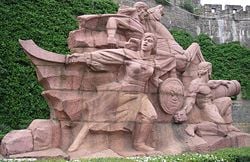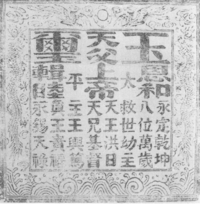Taiping Rebellion
| Taiping Rebellion | |||||||
|---|---|---|---|---|---|---|---|
| |||||||
| Combatants | |||||||
| Qing Empire | Taiping Heavenly Kingdom | ||||||
| Commanders | |||||||
| Xianfeng Emperor, Tongzhi Emperor, Empress Dowager Cixi | Hong Xiuquan, Yang Xiuqing, Xiao Chaogui, Feng Yunshan, Wei Changhui, Shi Dakai | ||||||
The Taiping Rebellion was a large-scale revolt, waged from 1851 until 1864, against the authority and forces of the Qing Empire in China, conducted by an army and civil administration inspired by Hakka, self-proclaimed mystics named Hong Xiuquan and Yang Xiuqing. Hong was an unorthodox Christian convert who declared himself the new Messiah and younger brother of Jesus Christ. Yang Xiuqing was a former salesman of firewood in Guangxi, who was frequently able to act as a mouthpiece of God to direct the people and gain himself a large amount of political power. Hong, Yang, and their followers established the Taiping Heavenly Kingdom (also, and officially, Heavenly Kingdom of Great Peace) and attained control of significant parts of southern China.
Most accurate sources put the total deaths during the fifteen years of the rebellion at about 20Â million civilians and army personnel,[1] although some argue the death toll was much higher (as many as 50Â million, according to one source).[2] Some historians estimate the combination of natural disasters combined with the political insurrections may have cost as many as 200 million Chinese lives between 1850 and 1865. That figure is generally thought to be an exaggeration, as it is approximately half the estimated population of China in 1851.[3] The war, however, qualifies as one of the bloodiest ever before World War II. It can be seen as a consequence of the meeting of the imperial powers and traditional China, which introduced new concepts and ideals about governance and people's rights, which clashed with existing custom. While the rebellion had popular appeal, its eventual failure may have stemmed from its inability to integrate foreign and Chinese ideas, which, arguably, the twentieth century Chinese leader, Mao Zedong achieved with his brand of Marxism as "socialism with Chinese characteristics."
Artifacts from the Taiping period can be seen at the Taiping Kingdom History Museum in Nanjing, China.
Beginning
In the mid-1800s, China suffered a series of natural disasters, economic problems, and defeats at the hands of the Western powers. The Qing Dynasty lost their war against Great Britain in the First Opium War. The ruling Qing dynasty (ethnically Manchu) was seen by the Chinese majority (ethnically Han) as ineffective and corrupt. Anti-Manchu sentiment was strongest in the south among the laboring classes, and it was these disaffected that flocked to the charismatic visionary Hong Xiuquan (a member of the Hakka minority). The sect's militarism grew in the 1840s, initially in response to its struggle to suppress bandits, but persecution by Qing authorities spurred the movement into a guerrilla insurrection and then into full-blown war.
The revolt began in Guangxi Province. In early January 1851, a ten-thousand strong rebel army routed Imperial troops stationed at the town of Jintian in what's now called the Jintian Uprising. Heavenly Kingdom forces successfully drove back the Imperial reprisal, and in August 1851, Hong declared the establishment of the Heavenly Kingdom of Peace (Taiping Tianguo) with himself as absolute ruler.
The revolt rapidly spread northward. In March 1853, between 700,000 and 800,000 Taiping soldiers took Nanjing, killing 30,000 Imperial soldiers and slaughtering thousands of civilians. The city became the movement's capital and was renamed Tianjing (in Wade-Giles: T'ang-chun; "Heavenly Capital").
Army of love

The rebellion's army was its key strength. It was marked by a high level of discipline and fanaticism. They typically wore a uniform of red jackets with blue trousers and grew their hair longâin Chinese, they were known as ChĂĄngmĂĄo (meaning "long hair"). The large numbers of women serving in the Taiping Heavenly Army also distinguished it from other nineteenth century armies.
Combat was always bloody and extremely brutal, with little artillery but huge forces equipped with small arms. By 1856, the Taiping armies numbered just over 1 million. Their main strategy of conquest was to take major cities, consolidate their hold on the cities, then march out into the surrounding countryside to battle Imperial forces. Although most modern estimates never put the Taiping Heavenly Army as numbering much more than a million in total, contemporary estimates placed its numbers far higherâindeed it was said that the main Taiping Armies in central China, in 1860, numbered 2.5 million. If this figure were accepted as accurate (which it most likely is not), it would imply a total of 3 million soldiers or more.
The organization of a Taiping army corps was thus:
- 1 general
- 5 colonels
- 25 captains
- 125 lieutenants
- 500 sergeants
- 2,500 corporals
- 10,000 privates
- 13,156 men in total
These corps were placed into armies of varying sizes. In addition to the main Taiping forces organized along the above lines, there were also many tens of thousands (and possibly hundreds of thousands) of pro-Taiping groups that fielded their own forces of irregulars.
Ethnically, the Taiping Heavenly army largely consisted of racial minoritiesâprincipally the Hakka (a sub group of Han Chinese) and Zhuang. Hong Xiuquan and the other Taiping royals were Hakka. The second tier was a mixed group and included many Zhuang. Prominent at this level of command was Shi Dakai who was half-Hakka, half-Zhuang, and spoke both languages fluently, making him quite a rare asset to the Taipings. Toward the later stages of the war, the number of Han (the dominant majority ethnic group of China) in the army increased substantially, but minorities remained prominent the whole time. There were almost no prominent leaders among the Taipings who were Han. It is believed that Zhuang constituted as much as 25 percent of the Taiping army.
Socially and economically, the Taipings came almost exclusively from the lowest classes. Many of the southern Taiping troops were former miners, especially those coming from the Zhuang. Very few Taipings, even in the leadership caste, came from the imperial bureaucracy. Almost none were landlords and in occupied territories landlords were often executed. In this sense, the Taiping army was a prototype for the People's Liberation Army of the twentieth century.
Opposing these forces was an imperial army of more than 2 million (possibly as large as 5 million) with something on the order of hundreds of thousands of regional militias and foreign mercenaries operating in support. Among the imperial forces was the elite Ever Victorious Army, consisting of Chinese soldiers led by a European officer corps (officers such as Frederick Townsend Ward and Charles Gordon). A particularly famous imperial force was the Xiang Army of Zeng Guofan.
From the above, it is obvious that establishing reasonable figures for the sizes of the opposing armies is very difficult. Although keeping accurate records was something Imperial China traditionally did very well, the decentralized nature of the Imperial war effort (relying on regional forces) and the fact that the war was a civil war and therefore very chaotic meant that reliable figures are impossible to find. The destruction of the Heavenly Kingdom also meant that any records it possessed were destroyed.
Though almost certainly the largest civil war of the nineteenth century (in terms of numbers under arms), it is debatable whether the Taiping Rebellion involved more soldiers than the Napoleonic Wars earlier in the century, and so it is uncertain whether it was the largest war of the nineteenth century.
At the Third Battle of Nanking in 1864, more than 100,000 were killed in three days.
Theology

Although ostensibly Christian, the "Kingdom of Heavenly Peace" has long been considered heretical by major branches of Christianity.
The movement's founder, Hong Xiuquan, had tried and failed to earn his shengyuan civil service degree numerous times. After one such failure, Hong had overheard a Chinese Protestant missionary preaching and taken home some Bible tracts, including a pamphlet titled "Good Words for Exhorting the Age." Then, in 1843, after his final failure, he had what some regard as a nervous breakdown and others as a mystical revelation, connecting his in-depth readings of the Christian tracts to strange dreams he had been having for the past six years. In his dreams, a bearded man with golden hair gave him a sword, and, with a younger man Hong addressed as "Elder Brother," taught him how to slay evil spirits (Spence 1999, 172).
Based on his readings, Hong Xiuquan came to believe that the figures in his dreams were God the Father and Jesus Christ, and that they were revealing his destiny as a slayer of demons and the leader of a new Heavenly Kingdom on Earth.[4]
Hong developed a literalist understanding of the Bible, which soon gave rise to a unique theology. He rejected the doctrine of the Trinityâonly the Father was truly God. Jesus Christ was the Father's firstborn Son, with Hong Xiuquan proclaiming himself as the Father's second Son and the younger brother of Jesus. It was said that when foreign missionaries later explained to Hong Xiuquan that Jesus was the Father's only Son, he simply crossed out the word "only." The Holy Spirit, for Hong, was nothing more than a "Holy Wind" (a belief based on the poor translation skills of Christian missionaries); in fact, he later bestowed the title "Holy Wind the Comforter" to Yang Xiuqing, the Taiping leader who had most of the political power during the rebellion.
Based on his readings and personal revelations, Hong Xiuquan added a third book, in addition to the Old Testament and the New Testament, to the Taiping regime's Bible.
The Kingdom's policies
Within the land that they controlled, the Taiping Heavenly Army established a theocratic and highly militarized rule.
- The subject of study for the examinations for officials (formerly civil service exams) changed from the Confucian classics to the Christian Bible.
- Private property ownership was abolished and all land was held and distributed by the state.
- A solar calendar replaced the lunar calendar.
- The society was declared classless and the sexes were declared equal. It was the first Chinese regime ever to admit women into examinations.
- Foot binding was banned.
- Monogamy was promoted.
- Other new laws were promulgated including the prohibition of opium, gambling, tobacco, alcohol, polygamy (including concubinage), slavery, and prostitution.
However, the rule was remarkably ineffective, haphazard, and brutal; all efforts were concentrated on the army, and civil administration was very poor. Rule was established in the major cities, but the land outside the urban areas was little regarded. Even though polygamy was banned, it was believed that Hong Xiuquan had 88 concubines. Many high-ranking Taiping officials kept concubines as a matter of prerogative, and lived as de facto kings.
In its first year, the Heavenly Kingdom minted coins that were 23Â mm to 26Â mm and around 4.1Â g. The inscription "The Heavenly Kingdom of Great Peace") was on the front, where "Kingdom" and "Holy Treasure" on the back.
Administration
Ranked below the King of Heaven, Hong Xiuquan, the territory was divided among provincial rulers called kings or princes, initially there were fiveâthe Kings of the Four Quarters and the King of the Yi (meaning flanks). Of the original rulers, the West King and South King were killed in combat in 1852. The East King was murdered by the North King during a coup d'etat in 1856, and the North King himself was subsequently killed. The kings' names were:
- South King, Feng Yunshan (d. 1852)
- East King, Yang Xiuqing (d. 1856)
- West King, Xiao Chaogui (d. 1852)
- North King, Wei Changhui (d. 1856)
- Yi King, Shi Dakai (captured and executed by Qing Imperials in 1863)
The later leaders of the movement were "Princes:"
- Zhong Prince, Li Xiucheng (1823â1864, captured and executed by Qing Imperials)
- Ying Prince, Chen Yucheng (1837â1862)
- Gan Prince, Hong Rengan HĂłng RÄngÄn) (1822â1864, executed), cousin of Hong Xiuquan
- Fu Prince, Hong Renda (executed by Qing Imperials in 1864), Hong Xiuquan's second eldest brother
- Tian Gui (Tien Kuei) (d. 1864, executed)
Other princes include:
- An Prince, Hong Renfa, Hong Xiuquan's eldest brother
- Yong Prince, Hong Rengui
- Fu Prince, Hong Renfu
Climax
At its height, the Heavenly Kingdom encompassed much of south and central China, centered on the fertile Yangtze river valley. Control of the river meant that the Taipings could easily supply their capital at Nanjing (which they renamed Tianjing). From there, the Taipings continued their assault. Two armies were sent west, to secure the upper reaches of the Yangtze. Two more armies were sent north to take the Imperial capital, Beijing. Potentially, these two expeditions could have acted as a giant pincer movement across the country. The western expedition met with some mixed success, but the attempt to take Beijing failed after being repulsed at the outskirts of Tianjin.
Downfall

In 1853, Hong withdrew from active control of policies and administration. His sanity progressively eroding, he devoted himself to meditation and more sensual pursuits, including his private harem.
With their leader largely out of the picture, Taiping delegates tried to widen their popular support with the Chinese middle classesâand to forge alliances with European powersâbut failed on both counts. Inside China, the rebellion faced resistance from the traditionalist middle class because of their hostility to many long-standing Chinese customs and Confucian values. The land-owning upper class, unsettled by the Taipings' peasant mannerisms and their policy of strict separation of the sexes, even for married couples, sided with the Imperial forces and their Western allies.
Following a setback near Beijing, they continued to expand westward, but spent most of their efforts maintaining their hold in the Yangtze valley. From 1860, the kingdom's fall was rapid.
An attempt to take Shanghai in August 1860, was repulsed by troops under the command of Frederick Townsend Ward, a force that would later become the "Ever Victorious Army" led by "Chinese" Gordon. Imperial forces reorganized under the command of Zeng Guofan and Li Hongzhang, and the Imperial reconquest began in earnest. By early 1864, Imperial control in most areas was well established.
Hong declared that God would defend Tianjing, but in June, with Imperial forces approaching, he died of food poisoning as the result of ingesting wild vegetables as the city began to run out of food. His body was buried in the former Ming Imperial Palace where it was later exhumed by the conquering Zheng to verify his death, then cremated. Hong' ashes were later blasted out of a canon, so as to have no resting place as eternal punishment for the uprising.
Four months before the fall of the Heavenly Kingdom of Taiping, Hong Xiuquan passed the throne to Hong Tianguifu, his eldest son. However, Hong Tianguifu was unable to do anything to restore the Kingdom, so the Kingdom was quickly destroyed when Nanjing fell to the Imperial armies after vicious street-by-street fighting.
Most of the princes were executed by Qing Imperials in Jinling Town, Nanjing.
The Nian Rebellion (1853â1868), and several Muslim rebellions in the southwest (1855â1873) and the northwest (1862â1877) were led by the remnants of the Taiping rebels.
Taiping Rebellion in popular culture
- Both China's CCTV and Hong Kong's ATV made historical dramas about Taiping Rebellion. The series on CCTV ran for 50 episodes.
- A strategy computer game based on the Taiping Rebellion has been made in China, and is primarily available in mainland China and Taiwan. The player can play as either the Qing government or the Taiping Rebels.
- Taiping societyâin some sources, the Heavenly King himself, is given credit for developing the popular Chinese game of Mahjong. Mahjong tile designs form the basis of the computer memory game, Shanghai.
- Flashman and the Dragon (1986)âA portion of the memoirs of the fictional Harry Paget Flashman recounting his adventures during the Anglo-Chinese Second Opium War and Taiping Rebellion.
- The Consumer Goods' song, "Taiping Riverboat," from their 2006 album, Pop Goes the Pigdog! tells of the construction of Nanjing and the subsequent defense of the Heavenly Kingdom through a first-person narrative.
Notes
- â Matthew White, Statistics of Wars, Oppressions and Atrocities of the Nineteenth Century. Retrieved August 8, 2007
- â R.J. Rummel, Genocide. Retrieved August 8, 2007.
- â Columbia University, China's Population Growth Throughout History.
- â Richard Hooker, The Taiping Rebellion. Retrieved August 8, 2007.
ReferencesISBN links support NWE through referral fees
- Carr, Caleb. The Devil Soldier: The American Soldier of Fortune Who Became a God in China. New York: Random House, 1994. ISBN 0-679-76128-4
- Hsiu-ch°ĂȘng Li, trans. The Autobiography of the Chung-Wang (Confession of the Loyal Prince). Shanghai: Presbyterian Mission Press, 1865.
- Lindley, Augustus. Ti-ping Tien-Kwoh: The History of the Ti-Ping Revolution. London: Day & Son, 1866.
- Reilly, Thomas R. The Taiping Heavenly Kingdom: Rebellion and the Blasphemy of Empire. Seattle: University of Washington Press, 2004. ISBN 0-295-98430-9
- Spence, Jonathan D. The Search for Modern China. New York: Norton, 1999. ISBN 9780393027082
- Spence, Jonathan D. God's Chinese Son: The Taiping Heavenly Kingdom of Hong Xiuquan. New York: W.W. Norton, 1996. ISBN 0-393-03844-0
Credits
New World Encyclopedia writers and editors rewrote and completed the Wikipedia article in accordance with New World Encyclopedia standards. This article abides by terms of the Creative Commons CC-by-sa 3.0 License (CC-by-sa), which may be used and disseminated with proper attribution. Credit is due under the terms of this license that can reference both the New World Encyclopedia contributors and the selfless volunteer contributors of the Wikimedia Foundation. To cite this article click here for a list of acceptable citing formats.The history of earlier contributions by wikipedians is accessible to researchers here:
The history of this article since it was imported to New World Encyclopedia:
Note: Some restrictions may apply to use of individual images which are separately licensed.
